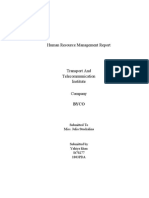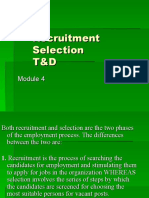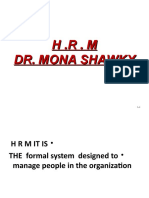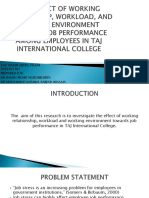HRD Matrix
HRD Matrix
Uploaded by
Chhavi GargCopyright:
Available Formats
HRD Matrix
HRD Matrix
Uploaded by
Chhavi GargOriginal Description:
Original Title
Copyright
Available Formats
Share this document
Did you find this document useful?
Is this content inappropriate?
Copyright:
Available Formats
HRD Matrix
HRD Matrix
Uploaded by
Chhavi GargCopyright:
Available Formats
This BlogLinked From HereThe Web This Blog Linked From Here The Web Wednesday, May 12,
2010 HRD MATRIX The HRD matrix shows the interrelationship between HRD instruments, processes, o utcomes and organizational effectiveness. HRD Instruments: These include performance appraisal, counseling, role analysis, potential development, training, communication policies, job rotations, rewards, job enrichment programmes, etc. These instruments may vary depending on the siz e of the organization, the internal environment, the support and commitment of t he top management, the competitive policies etc. HRD Processes: The HRD instruments lead to the generation of HRD processes like r ole clarity, performance planning, development climate, risk-taking, dynamism in employees. Such HRD processes should result in more competent, satisfied and co mmitted people that would make the organization grow by contributing their best to it. HRD Outcomes: HRD instruments and processes make people more committed and satisf ied, where they tend to give their best to the organization enthusiastically. Organizational Effectiveness: The HRD outcomes influence the organizational effec tiveness, which in turn, depends on a number of variables like environment, tech nology, competitors, etc.
A Schematic Presentation of Linkages between HRD Instruments, Processes, Outcome s and Organizational Effectiveness
HRD Mechanisms or Subsystems: Many HRD mechanisms are available to develop the competencies of employees and i mproved the overall organizational climate. The major ones are discussed below: 1.Performance Appraisal: performance appraisal have become increasingly importan t tools for organizations to use in managing and improving the performance of em ployees, in making timely and accurate staffing decisions and improving the over all quality of the firms products and services. The appraisal process is the for mal way of evaluating the employee s performance. Its purpose is to provide an acc urate picture of post and future employee s performance. To meet this performance appraisal are set. The targets are based on job related criteria that best deter mine successful job performance. Where possible actual performance is measured d irectly and objectively. Using a wide variety of techniques, specialists select an appropriate method to measure an employee s actual performance against the prev iously set targets. The process is used to strengthen the effort performance lin
kage. Appraisals help an organization communicate its expectations regarding per formance and connection between performance and reward to employees. They increa se employees confidence and employees feedback that their efforts are being adequa tely rewarded. The feedback is offered through an evaluation interview. Here the rater tries to give both positive and negative sides of the employee performanc e. To be useful, raters or supervisors should use HRD orientated appraisals as a mechanism to: a.Uncover difficulties faced by the subordinate while handling assigned task and try to remove these hurdles. b.Understand the strengths and weaknesses of subordinates and help the subordina tes overcome the obstacles in the way. c.Encourage subordinates to meet problems head-on, accept responsibilities and f ace challenges with confidence and courage. d.Plan for effective utilization of the talents of subordinates. 2.Potential Appraisal: the term potential refers to the abilities possessed by an employee but not put to use currently or the abilities to assume challenging res ponsibilities in future assignments. The term performance refers to one s skills, ab ilities in meeting the requirements of the job which one is holding currently. P otential appraisal is different from performance appraisal which shows an employ ee s current performance in his existing role. If the employee is required to play a completely different set of roles at the higher levels, potential appraisal n eeds to be carried out at regular intervals. The objective of potential appraisal is to identify the potential of a given employee to occupy higher positions in the organizational hierarchy and undertaken higher technologies. The appraisal is carried out on the basis of (i) supervisor s observations; (ii) performance data relating to various previous roles played by an employee; (iii) performance on r oles in simulating to a new position. A good potential appraisal system helps ma nagement to pick up a suitable candidate for a given job and offer additional tr aining, if necessary. 3.Career Planning: a career is a sequence of positions held by a person in the c ourse of a lifetime. Career planning is a process of integrating the employees ne eds and aspirations with organizational needs. Career programmes and HR programm es are linked to the degree that they help each individual meet individual and o rganization requirements. In the HRD system, the long term growth plans of a company are not kept secret. They are made known to the employees. Major changes are discussed at all levels to promote understanding and commitment among employees. The immediate concern o f employees would be to find out where do stand in such a road map. Do they have any chance to grow while building the organization brick by brick? Since manage rs have information about the growth plans of the company, they need to transmit their information to their subordinates. The subordinates should be assisted in planning their careers within the company. It is, however, not necessary that e ach one of them would scale new heights every year but atleast they are aware of the opportunities and get ready for greater challenges ahead. Career planning d oesn t guaranty success. But without it, employees are rarely prepared to encash t he opportunities that come their way.
4. Training and Employee Development: Training has gained importance in present day environment where jobs are change rapidly. Training is a learning experience designed to achieve a relatively permanent change in an individual that will im prove the ability to perform on the job. Employee development on the other hand is a future oriented training process, focusing on the personal growth of the em ployee. Both training and development focus on learning. Training programmes sho uld not be designed as quick fixes for organizational problems, nor should they
depend on faddish techniques just because they are popular now and are followed by our next door neighbor. Instead, training should be planned to meet the speci fic needs of the organization and its employees. To survive and grow in a compet itive environment, organizations have to motivate their employees to get ready f or all kinds of future challenges. 5. Organisation Development: Organizations are never perfectly static. They keep on changing. Employees skills and abilities, therefore, require continual upgrading. The future is uncertain when full of surprises. It is not easy to fight the force of change without adeq uate preparation and training. A systematic planned way of managing this change is through the process of OD. OD may be defined as a change effort that is planned, focused on an entire organ ization or a large subsystem, managed from the top, aimed at enhancing organizat ional health and effectiveness and based on planned interventions made with the help of change agent or third party who is well versed in the behavioral science . 6. Rewards: People do what they do to satisfy needs. They choose to behave in way which will maximize their rewards. The most obvious reward is pay but there are many other s. Intrinsic rewards come from their job itself such as feelings of achievement, pride in doing a job etc. Extrinsic rewards come from a source outside the job including pay, promotion and benefits offered by management. Reward could be lin ked to performance as well to motivate high achievers to do well. If rewards are allocated completely on non-performance factors such as seniority, job titles e tc. then employees are likely to reduce their efforts. Now days organizations al so use team based rewards to motivate empowered work teams to exceed established targets.
7. Employee welfare & quality of work life (QWL): The term employee welfare mean s the efforts to make life worth living for workmen . It includes various services, facilities & benefits offered to employees by the employers, unions & govt. The purpose is to improve the living standards of workers & thereby improve the qua lity of work life. Employees voluntarily extend a number of benefits to employee s in the hope that these indirect compensation plans motivate employees to perfo rm better. Over the years, the types of benefits offered have been expanding in line with competitive pressures, changing job market trends, employee expectatio ns, union demands & legislative requirements. Quality of work life (QWL) efforts are systematic efforts by organizations to gi ve workers a greater opportunity to affect the way they do their jobs & the cont ributions they make to the organization s overall effectiveness. It is a way of em powering employees by giving them a greater say in the decision making process. QW L means having good working conditions, good wages & benefits, good leadership & interesting, challenging jobs. QWL efforts include the following: Employee involvement: Here employees are given the opportunity to participate in the decisions that affect them & their relationship in the company. Quality circles: These are small group of employees who meet regularly to find, a nalyse & solve quality & other work-related problems of a particular department/ section/area.
Socio-technical systems: These are interventions in the work situation that redes ign the work, the workgroups & the relationship between workers & the technologi es they use to perform their jobs. Co-determination: In this method, representatives of workers meet mgt in a formal way to discuss & vote important decisions that affect the lives of workers. Self-managed work teams: These are employee groups (also called autonomous workgr oups) with a high degree of decision-making, responsibility & behavioural contro l for completing their work. The team is usually given the responsibility for pr oducing an entire product or service. Suggestion programmes: It is a formal method for generating, evaluating & impleme nting employee ideas. Open door policies: Where open door policies exist, employees are free to walk in to any manager s office with their problems & seek solutions to such problems. HRD system focus on employee welfare & QWL by continually examining employee nee ds & meeting them to the best possible extent. Human resource information system: Human resource information system (HRIS) is a method by which an organization collects, maintains & reports information on pe ople & jobs, the information is generally stored in a central human resource dat a bank, preferably in a computer containing the following details: Personal data: Identification, education, reserved category, place of origin, etc .; Recruitment data: Entry date, grade in aptitude tests, grade in leadership tests; Experience data: Placement history, promotions, tasks performed grade wise; Appraisal data: Appraisal on each job, ratings of behaviours in a group, commitme nt to overall goals, etc.; Training data: Nature of training received at each level, current training assign ment, etc.; Miscellaneous: Health status, personal problems, security needs, record of incent ives received, absence & sickness data, etc.; This information is put to use whenever there is a need to identify employees fo r certain special assignments. Each of the subsystems described contribute to the achievement of overall HRD go als. Performance & potential appraisal helps an employee develop his role capabi lities & prepare himself for future changes. Training improves his learning abil ities. Feedback & performance coaching helps him correct mistakes & improve inte rpersonal relationships. OD promotes the collaborative spirit & self-renewing sk ills. Rewards & welfare amenities enrich the life of employees & help them carry out the assigned tasks with zeal & enthusiasm. It should be remembered that the subsystems discussed above should not be viewed in isolation. They are all inte r connected & independent parts. When viewed in isolation, they do not offer the synergistic advantages of a well developed HRD system.
THE CONTRIBUTION OFSUBSYSTEMS TO HRD GOALS The subsystems described already, contributes to the achievement of overall HRD goals performance appraisal helps an individual to develop his current role capa bilities. Potential appraisal focuses on identifying the employee s likely future roles with in the organization. Training helps an employee to improve his job kn owledge and skills. It enables an employee to do his current job more efficientl y and prepare himself for a higher level job .It bridges the gap between job req uirements and employee s skills, knowledge and behavior .Feedback and performance coaching helps the development of the individual as well as interpersonal relati onships. Organization development aims at developing team spirit and self-renewi ng skills. Welfare amenities, rewards and incentives improve the quality of life of employees and make the work place a stimulating one for employees .The contr ibution of these HRD subsystems to various development dimensions is shown in th e bellow table.
The HRD mechanisms described above should not be viewed in isolation .They are d esigned to work together in an integrated system, although they may cast in an o rganization that does not have an overall HRD plan .the collective benefits of i ntegrated mechanisms may not accrue to an organization ,when these are viewed in isolation . each subsystem is inter-linked to other subsystems and offer rich b enefits to an organization when they are well integrated.
THECONTRIBUTION OF HRD SUBSYSTEM TO DEVELOPMENT DIMENSIONS Development dimensions HRD subsystems Mechanism Individual Training Career planning Potential appraisal and development Feedback and coaching performance Rewards Individual in the present role Performance appraisal Training Feedback and performance coaching
Rewards Individual in regard to likely future roles Potential appraisal and development Training Performance appraisal Feedback and performance coaching Dyadic relationships Feedback and performance coaching Performance appraisal Training Teams & teamwork Organization development Training Team rewards Collaboration among different units/teams Organization development Training Self-renewing capability and health of organization Performance appraisal Organization development Training
Principles in Designing HRD Systems In order to realize the benefits of integrated HRD systems, top management must invariably observe certain principles which are categorized below: Management Support: HRD requires consistent support from managers working at var ious levels. They must formulate the HRD policies keeping organizational require ments in mind and implement these wholeheartedly. Focus of the HRD System: The system must be designed keeping various contextual factors such as size, technology, skill levels, support for function, in mind. I t must focus on developing human resources at various levels (problem solving ca pabilities leading to increased employee productivity) and commitment. It must t ake the organization forward by anticipating changes and preparing people for fu ture challenges. It must be properly integrated with other long range functions such as corporate planning, budgeting, etc. Line managers must be actively invol ved in all the above steps.
Structure of the HRD System: The system must have a distinct identity of its own , headed by a senior manager taking care of the implementation process. The HR d epartment created for this purpose must have proper linkages with outside system s as well as internal subsystems. The system must be reviewed periodically so as to find out the progress and effectiveness of the programme. Functioning of the System: The system must provide for appropriate feedback from various departments at regular intervals. It is better to quantify the various aspects of HRD and arrange for storage of data in computers. Internal experts an d external consultants could be judiciously used to offer training to various de partments/ persons. Various aspects of HRD should be introduced in a gradual way , after a thorough review of the organization s size, its needs and level of sophi stication. Each stage shou
Read more: http://mbaseminars.blogspot.com/2010/05/hrd-matrix-hrd-matrix-shows.h tml#ixzz1vIXlP02Z
You might also like
- KEPL MR 06 - Management Review MeetingDocument2 pagesKEPL MR 06 - Management Review MeetingAvijit SenNo ratings yet
- EP-04-01 Control of Document Rev00Document7 pagesEP-04-01 Control of Document Rev00Ujij IrelehcNo ratings yet
- Performance Related PayDocument14 pagesPerformance Related PayMoogiiNo ratings yet
- Chapter 10 - Understanding Work TeamsDocument10 pagesChapter 10 - Understanding Work TeamsJet PadernalNo ratings yet
- Lesson 3 - Designing Organization For Quality and Quality PolicyDocument20 pagesLesson 3 - Designing Organization For Quality and Quality Policycelestetorino1No ratings yet
- Employee Confirmation Form-Shyam LDocument2 pagesEmployee Confirmation Form-Shyam Lsanjay kumar100% (1)
- Chapter 3-Culture and Communication - RetailDocument22 pagesChapter 3-Culture and Communication - Retailfcleong69No ratings yet
- Accountability Buddy GuidelinesDocument4 pagesAccountability Buddy GuidelinesPyae Sone KyawNo ratings yet
- Career Management PolicyDocument21 pagesCareer Management PolicyIber TavershimaNo ratings yet
- Safety InteractionDocument5 pagesSafety InteractionSri KanthNo ratings yet
- Chapter 8Document12 pagesChapter 8Kristen IjacoNo ratings yet
- Talent Management ProcessDocument2 pagesTalent Management ProcessRanjana BandaraNo ratings yet
- Merit Pay and Variable PayDocument12 pagesMerit Pay and Variable PayRyan BuerNo ratings yet
- Legal ComplaincesDocument37 pagesLegal ComplaincesUjjwal AnandNo ratings yet
- Auditing and Accountability PolicyDocument6 pagesAuditing and Accountability PolicyLayer8 IOTNo ratings yet
- Formal and Informal TrainingDocument28 pagesFormal and Informal TrainingShahrez Khan100% (1)
- CHRO Trends 2021: Insights From Fortune 200 Chief Human Resources Officer Changes, Demographics, and PrioritiesDocument11 pagesCHRO Trends 2021: Insights From Fortune 200 Chief Human Resources Officer Changes, Demographics, and PrioritiesAlberto RoitmanNo ratings yet
- Exiting Employee Checklist: Type of TerminationDocument2 pagesExiting Employee Checklist: Type of TerminationsalmanquNo ratings yet
- Attitude Scales - Rating Scales To Measure Data PDFDocument10 pagesAttitude Scales - Rating Scales To Measure Data PDFChinmoy DasNo ratings yet
- Employee Satisfaction Survey QuestionsDocument6 pagesEmployee Satisfaction Survey QuestionsGlaizza Marie VerdaderoNo ratings yet
- HR Report byDocument13 pagesHR Report byShahadat Khan100% (1)
- Recruitment Selection T&DDocument16 pagesRecruitment Selection T&DGarima BehlNo ratings yet
- Employee Handbook - October 2019 - AppendixDocument20 pagesEmployee Handbook - October 2019 - Appendixsie kingNo ratings yet
- Raging Debates in HR AnalyticsDocument5 pagesRaging Debates in HR AnalyticsNkvNo ratings yet
- Editing MIBD Staff HandbookDocument34 pagesEditing MIBD Staff Handbookajaya nathNo ratings yet
- HRM 111Document21 pagesHRM 111Charles MasanyiwaNo ratings yet
- Human Resource Manager Job DescriptionDocument2 pagesHuman Resource Manager Job DescriptionPraveenNo ratings yet
- Data Retention Policy ScheduleDocument13 pagesData Retention Policy ScheduleSanda NechiforNo ratings yet
- Retail AuditDocument36 pagesRetail Auditdeepak bijjuNo ratings yet
- AI in HRM ReportDocument12 pagesAI in HRM Reportriyatiwari080102No ratings yet
- Employee EngagmentDocument17 pagesEmployee Engagmentahmed HammoudNo ratings yet
- Ms. Swati - PPT - HR AUDIT - Week1 - Session 5 - 28th March 2020Document50 pagesMs. Swati - PPT - HR AUDIT - Week1 - Session 5 - 28th March 2020Ananya100% (1)
- Employee Performance EvalutionDocument5 pagesEmployee Performance EvalutionVijay PradeepNo ratings yet
- SOP - Employee Satisfaction SurveyDocument4 pagesSOP - Employee Satisfaction Surveygirijams2011No ratings yet
- SOP For Maintenance of Organization Structure (Placement Chart) - GG IndiaDocument3 pagesSOP For Maintenance of Organization Structure (Placement Chart) - GG IndiaPradeep KumarNo ratings yet
- Competency Profile (CP)Document9 pagesCompetency Profile (CP)nizam1372No ratings yet
- B5 - 7. Staff Handbook - HKDocument44 pagesB5 - 7. Staff Handbook - HKhkiskennithNo ratings yet
- Purpose To Ensure Replacements For Key Job Incumbents in Executive, Management, Technical, andDocument2 pagesPurpose To Ensure Replacements For Key Job Incumbents in Executive, Management, Technical, andezekielbidesNo ratings yet
- Career Pathways TemplateDocument4 pagesCareer Pathways TemplateFaula Iman SitompulNo ratings yet
- Performance Evaluation and ImprovementDocument30 pagesPerformance Evaluation and Improvementsanthosh n prabhuNo ratings yet
- Roles and Responsibilities of Human Resource Department - TuteboxDocument4 pagesRoles and Responsibilities of Human Resource Department - TuteboxMrityunjoy RoyNo ratings yet
- Policy Succession PlanningDocument2 pagesPolicy Succession PlanningMadhu SmitaNo ratings yet
- A Framework For Auditing HRDocument11 pagesA Framework For Auditing HRadedoyin123No ratings yet
- HR Audit TorsDocument3 pagesHR Audit TorsShumyla Kanval0% (1)
- HR Practices in Insurance IndustriesDocument25 pagesHR Practices in Insurance IndustriesParth SarthyNo ratings yet
- P - HR Audit Check List - GOODDocument12 pagesP - HR Audit Check List - GOODapi-3829428No ratings yet
- The Learning OrganisationDocument4 pagesThe Learning Organisationmba departmentNo ratings yet
- Your TurnDocument4 pagesYour TurnHadeel AL Jobour100% (1)
- A Guide To Conducting A Training Needs AnalysisDocument14 pagesA Guide To Conducting A Training Needs AnalysisMalappareddyNo ratings yet
- Grievance Handling PolicyDocument4 pagesGrievance Handling Policymaka007No ratings yet
- Hierarchical Organizational StructureDocument2 pagesHierarchical Organizational StructureSetu ChawlaNo ratings yet
- Soft HR PlanningDocument3 pagesSoft HR PlanningKasim MalikNo ratings yet
- CLC Onboarding ChecklistDocument3 pagesCLC Onboarding ChecklistMonica StanciuNo ratings yet
- Employee Training Log TemplateDocument2 pagesEmployee Training Log TemplateKhalidNo ratings yet
- People - Capability Maturity Model (People - CMM) : Group 4 Abhishek Kabra (Mba) Shubham Nautiyal (Mba) Shivangi Rai (PHD)Document24 pagesPeople - Capability Maturity Model (People - CMM) : Group 4 Abhishek Kabra (Mba) Shubham Nautiyal (Mba) Shivangi Rai (PHD)Itti SinghNo ratings yet
- HRMS Implementation ChecklistsDocument7 pagesHRMS Implementation ChecklistsAbdelmadjid BouamamaNo ratings yet
- Annotated Bibliography MotivationDocument5 pagesAnnotated Bibliography MotivationGayatri VenugopalNo ratings yet
- Recruitment Agencies 2011Document2 pagesRecruitment Agencies 2011Mahmoud Abo ZiedNo ratings yet
- NikitaPugaonkar (4 0)Document3 pagesNikitaPugaonkar (4 0)Jagdeep SinghNo ratings yet
- Entrepreneur: Jurnal Bisnis Manajemen Dan KewirausahaanDocument12 pagesEntrepreneur: Jurnal Bisnis Manajemen Dan KewirausahaanDede BhubaraNo ratings yet
- RetentionDocument35 pagesRetention4179309No ratings yet
- Lecture 1 - Performance AppraisalDocument47 pagesLecture 1 - Performance Appraisalmaiesha tabassumNo ratings yet
- Valtera White Paper Employee EngagementDocument12 pagesValtera White Paper Employee Engagementraluca_draguna8636No ratings yet
- H.R.M Dr. Mona ShawkyDocument24 pagesH.R.M Dr. Mona ShawkyLara IbrahimNo ratings yet
- List of HRM TopicsDocument2 pagesList of HRM Topicsapi-377191775% (4)
- The Function of The Human Resource Management in Contributing To Organizational PurposesDocument2 pagesThe Function of The Human Resource Management in Contributing To Organizational PurposesSaima ArshadNo ratings yet
- Job Description - Senior HR ManagerDocument2 pagesJob Description - Senior HR Managernivi gowdaNo ratings yet
- Lunenburg, Fred C Motivating by Enriching Jobs IJMBA V15 N1 2011Document11 pagesLunenburg, Fred C Motivating by Enriching Jobs IJMBA V15 N1 2011HafsaNo ratings yet
- HRDocument11 pagesHRnur saha afitaNo ratings yet
- Impact of Stress On Job Performance An Empirical Study of The Employees Printed PDFDocument4 pagesImpact of Stress On Job Performance An Empirical Study of The Employees Printed PDFUmer QureshiNo ratings yet
- Aaa College of Engineering and Technology: Question Bank - Unit - 3Document2 pagesAaa College of Engineering and Technology: Question Bank - Unit - 3Jegatheeswaran BoompandiNo ratings yet
- Human Resource Management: Chapter TwelveDocument15 pagesHuman Resource Management: Chapter Twelvemuhammad farhanNo ratings yet
- Soft & Hard Model of HRMDocument28 pagesSoft & Hard Model of HRMTabassum Farhana100% (3)
- Human Resources Organogram-Rajahmundry Asset: Admin/EstateDocument4 pagesHuman Resources Organogram-Rajahmundry Asset: Admin/EstateSUDEEP KUMARNo ratings yet
- HRM ProjectDocument18 pagesHRM Projectapi-548957114No ratings yet
- The Influence of Competence, Motivation, and Organisational Culture To High School Teacher Job Satisfaction and PerformanceDocument8 pagesThe Influence of Competence, Motivation, and Organisational Culture To High School Teacher Job Satisfaction and PerformanceTâm NguyễnNo ratings yet
- Case Questions Growing ManagersDocument1 pageCase Questions Growing ManagersGia AbbasiNo ratings yet
- HR Metrics With ExamplesDocument13 pagesHR Metrics With Examplesasuyata100% (1)
- Staff Appraisal Form-2012Document6 pagesStaff Appraisal Form-2012Cheri HoNo ratings yet
- Good Talent Management Practices (GTMP) : Semarang, 15 November 2010Document33 pagesGood Talent Management Practices (GTMP) : Semarang, 15 November 2010Adi Chandra SetiawanNo ratings yet
- 51 HR MetricsDocument4 pages51 HR Metricsnafiz100% (3)
- Project Report: Organization BehaviorDocument15 pagesProject Report: Organization BehaviorSharad PyakurelNo ratings yet
- Goal Setting TheoryDocument16 pagesGoal Setting TheorysuganyaNo ratings yet
- VivaDocument25 pagesVivaFaiz HakimNo ratings yet
- Aaa MCQDocument11 pagesAaa MCQswatiNo ratings yet

























































































